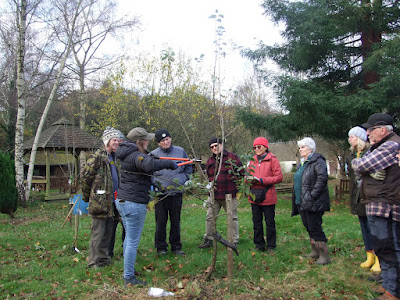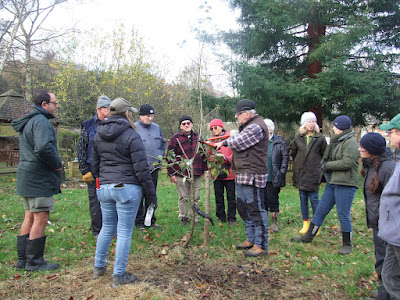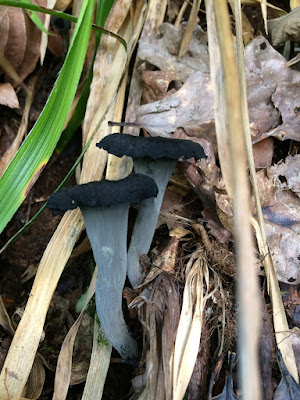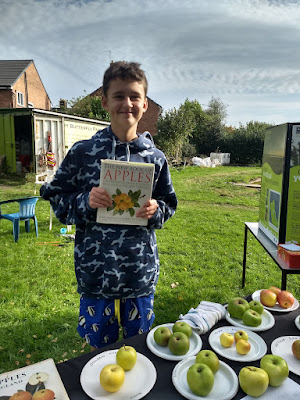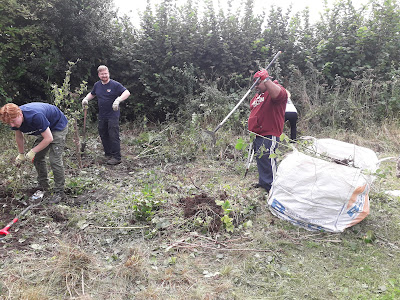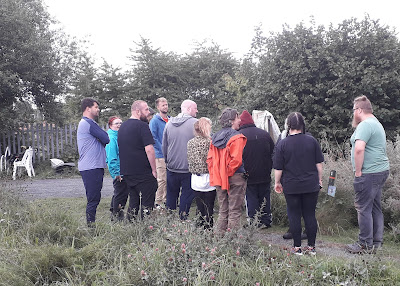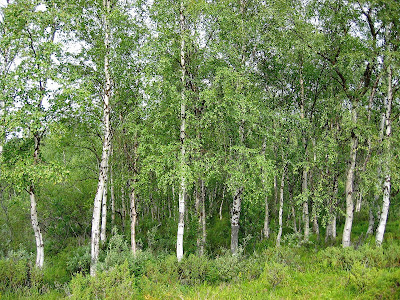 |
Looking carefully before pruning the Bramley tree planted by Alison McGovern MP and Stephen Ross in 2021. |
Sunday, 26 November 2023
Tree Pruning Workshop at Dibbinsdale
Friday, 27 October 2023
Fungal Foray at Dibbinsdale
 |
| Fungal Briefing by John Ratcliffe |
A third fungal foray was held by Wirral Wildlife at Dibbinsdale Local Nature Reserve. Prior to the foray a recognisance survey was undertaken by John Ratcliffe of North-West Fungal Group, and it was found to be a fungal desert as a result of the dry weather. John added “Our only hope is rain.” The Eventbrite attendees were emailed to warn them the host of fungi may not be as impressive or abundant as other years. Luckily for these fungal detectives it did rain, it rained so much that the path by Otter’s Tunnel under the railway was flooded and the planned route was altered. The autumn flowers of the fungi came out, though not very as abundant in numbers a respectable diversity of 52 species were recorded with 30 species not having been recorded on the previous fungal foray here.
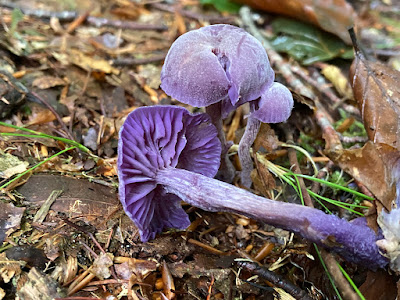 |
| Amethyst Deceiver |
The gills/pores of a mushroom head give 20 times the area of the mushroom for spores' dispersal. It can be quite daunting with all those new names in English and Latin, but as the attendees went along, they started recognising the fungi that were seen early in the foray. Crib sheets of the previous year’s fungal records were provided to help recall the names.
One fungus found was the Beef Steak mushroom which when you pressed it oozed out red dye as you see in a steak. Also found was the attractive Amethyst Deceiver and a Blushing Bracket. Clive, another fungal expert, was full of anecdotes about each fungus. Cramp balls, so called as you put them down your breeches when on a long horse ride to prevent cramp. Birch Polypore can be dried and used as a razor strop, or the fresh elastic skin peeled into a strip could be used like a sticking plaster, with the inside being clean. John was pleased to see attendees were all interested. One of the attendees, Ben Hart, typed up a list of the species seen on the day in the evening, including the common and Latin names. John, our fungal leader, searched for the Horn of Plenty on the damp rock cutting on the banks of the river Dibbin but unfortunately, we did not find that this time. We will look for it during next autumn’s Fungal Foray.
Thursday, 19 October 2023
Your Views Wanted on Local Nature Recovery Strategy
- Map our most important habitats
- Map opportunities for nature recovery
- List the priorities for reversing the decline in plant and animal species
A survey is live now and continuing until November 15th.
Please find the link to the survey here:
https://lcrlistens.liverpoolcityregion-ca.gov.uk/engagement/local-nature-recovery-strategy
Thursday, 12 October 2023
Apple Afternoon at New Ferry Butterfly Park
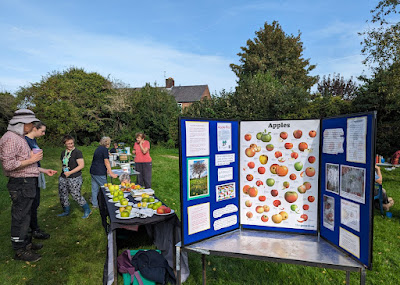 |
| A tasty display of apple varieties next to our apple information board |
Sunday 8th October was a warm October day - perfect weather for all things appley. Volunteers at New Ferry Butterfly Park organized an afternoon to celebrate locally grown apples. Thank you to everyone who visited.
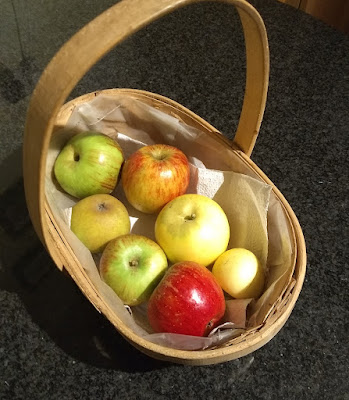 |
| A selection of apples to take home |
Many groups joined in the annual celebration and Wirral Wildlife began organising Apple Days. As far as I know the first Wirral Wildlife Apple Day was held on 19th October 1996 at Bob’s Orchard in Eastham.
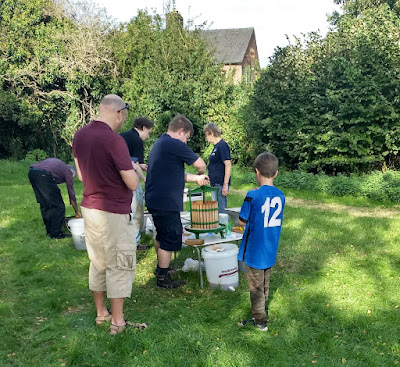 |
| Using the traditional wooden apple press to make juice |
Later it moved to Brimstage Hall and then we added a second day at Eastham Country Park. In the last Apple Day before Covid (Wirral Wildlife’s 22nd Apple Day) we had 28 varieties of apples from orchards at Brimstage, Willaston and Upton Hall School. We also had enough apples to juice using our traditional wooden press. The Mersey Morris Men danced and the Tree Wardens sold apple goodies like pies and jam.
 |
| Checking the apple juicing equipment |
This year we decided to reinstate a smaller version – an Apple Afternoon at New Ferry Butterfly Park. John Bateman collected apples and manned the apple press so that visitors could taste freshly pressed juice. We had 21 varieties of apples picked from Brimstage and Upton Hall School orchards plus two varieties from the NFBP committee chairman’s garden. What wonderful names these old varieties have – some dating back to the 17th century. Some varieties like Peasgood’s Nonsuch are named after the person who raised them. Others like Lord Lambourne are named after a person. Catshead is named because of its shape, Red Love for the colour of its skin and flesh and Bee Bench after the tradition of taking bee hives to orchards to pollinate the flowers. A full list of our varieties is given below.
 |
| The peeling machine in action |
Our apple peeling machine is always popular – who can create the longest piece of unbroken peel? This year the longest was 266 cm. Common Ground used to run a national competition and one year someone from our Apple Day won the under 16 competition with a piece 269 cm long. Maybe someone will break this record next year.
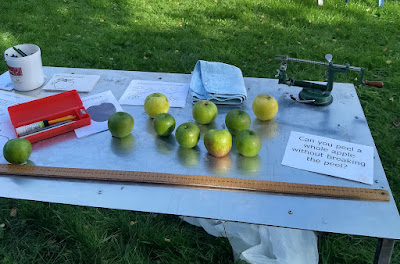 |
| Can you peel a whole apple without breaking the peel? |
So watch our Event listings for 2024 and put the Apple afternoon onto your calendar.
Apple varieties on display:
Annie Elizabeth
Arthur Barnes
Ashmead’s Kernel
Bee bench
Bramley
Burr Knott
Catshead
Court Pendu Plat
Crawley Beauty
Egremont Russett
Golden Noble
Grenadier
James Grieve
Lord Derby
Lord Lambourne
Peasgood’s nonsuch
Phil’s cooker
Red Love
Redsleeves
Ribston Pippin
Withington Welter
Worcester Pearmain
Tuesday, 26 September 2023
Seasonal Booster from AstraZeneca
 |
| Removing brambles from behind Brick Pit Coppice |
Another three equally strong employees used root slaying spades to remove encroaching blackthorn from the grasslands surrounding the pond, whilst another four took up scythes and mowed the herb rich, aromatic smelling calcareous grassland. It was easier and more effective than they thought and proved enjoyable.
 |
| Scything fun! |
 |
| The scything team |
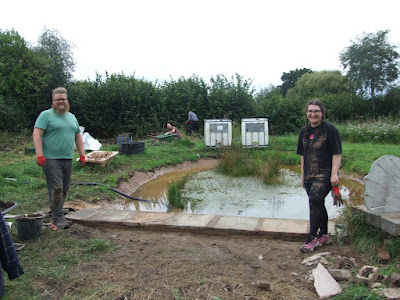 |
| Getting covered in clay while building a pond dipping platform! |
 |
| Getting the clay to the right consistency |
 |
| Making sure the paving stones are level |
This corporate workday really gave a great boost to the Park as we were able to finish the long ongoing project of restoring the pond, and start tackling the more vigorous projects of removing the blackthorn and bramble. The pond has been much missed during this last season by our visitors, as the Park is one of the few places you can just turn up on summer Sundays and see what lives in the pond using a net. Thanks go to John Bateman, New Ferry Butterfly Park Treasurer and AstraZeneca employee, and Sarah Edgar of AstraZeneca, who were instrumental in organising this corporate workday, as well as our own experienced volunteers who led the various projects. AstraZeneca in addition to providing employees also kindly purchased the breeze blocks, sand and cement for the pond dipping platform project to progress. We hope to get another seasonal shot from the Speke AstraZeneca team next year.
Monday, 18 September 2023
Late Summer Activity at Cleaver Heath
 |
| The main heather panel at Cleaver Heath |
During late August and early September two volunteer task days were organized at Cleaver Heath to deal with the annual problem of bracken re-growth within the upper heather panel. Bracken fronds were removed by stem pulling - rewarding work but laborious, especially in the recent very warm weather! After the main panel was cleared, we concentrated on clearing bracken and pruning overhanging trees along the edge of the Eastern woodland to allow more light to fall onto the nearby heather and encourage fresh growth.
 |
| The woodland edge after bracken pulling |
While working we took the opportunity to look out for any interesting wildlife especially as the weather was warm and sunny.
Gall wasps had been busy during the year and young oaks along the woodland edge displayed a variety of galls.
 |
| Galls on oak trees. Clockwise from top left: Marble Gall, Artichoke Gall, Cola-nut Gall, Spangle Gall, Knopper Gall |
The young oaks were also providing shelter and home to some spiders.
 |
| Lesser Garden spider (Metellina sp.) |
 |
| The 'Sputnik spider'
(Paidiscura pallens) so-called because of the spiky shape of its eggsac which is attached to the underside of an oak leaf |
By far the most interesting 'find' during the day was the Heather Ladybird (Chilocorus bipustulatus).
 |
| Heather Ladybird (Chilocorus bipustulatus) |
This very small ladybird was found on mature heather close to where we were working along the woodland edge. It is black and shiny with two or three red spots, sometimes fused, running in a line across the body. It is more likely to be found on mature heather on heathland as at Cleaver, but has been occasionally recorded on coastal dunes. It was recorded in the Wallasey sand dunes in 1991. Nationally it is classed as local and declining so we are very fortunate to have it with us! It feeds on aphids and scale insects and overwinters in litter at the base of heather and gorse.
Future work at Cleaver before the end of the year includes the regeneration project next month, birch cutting and stump treatment with Graham from Cheshire Wildlife Trust and coppicing within the managed scrub area. A lot to keep us busy.
John McGaw
Volunteer Warden, Cleaver Heath
Wednesday, 13 September 2023
End of Season Party at the Butterfly Park
On Sunday 10th September, to mark the last day of the 2023 opening season, the volunteers had an end of
season party. There were two other celebrations
that afternoon. First, the industrial history lectern by the brick pit was officially
unveiled in honour of Frank Cottrell.
 |
| Unveiling of the industrial history lectern, dedicated to Frank Cottrell |
Frank lived in Spital and worked at Unilever, after a short spell in the RAF - which left him with a military bearing and an impressive moustache.
Frank’s passion was butterflies, but there being no locally active branch of Butterfly Conservation, he became chair of Wirral Wildlife (1989 - 1998) and a trustee of Cheshire Wildlife Trust in 1992. He persuaded his fellow trustees that CWT should hold the Park's lease, opening up the way for the Park to start. Later he was a Sunday warden, with his friend Elaine Mills, retiring eventually at age 94! He gave a generous donation towards the new gates. Donations collected at Frank’s funeral were matched by Wirral Wildlife to enable the purchase of the lectern. It will help us display the history of the Park to visitors. The lectern is made of recycled plastic and aluminium, and we hope will last as long as Frank did - nearly 99 years.
 |
| Peter Miller, Paul Loughnane and Hilary Ash with the lectern |
The lectern display was created by Peter Miller and reflects the industrial legacy which has given the park such biodiversity. Howard Gibson and Peter put the lectern in together.
Following this the party moved to the Park’s entrance for a second celebration.
 |
| Steve Lyus and Phil Putwain raising the Green Flag |
Steve Lyus became the Chair of the Park committee in 2013 and was instrumental in redefining our relationship with Cheshire Wildlife Trust. He maintained the insurance cover, regularly reviewed risk assessments, kept the information board up to date and was a logical head at the Park committee meetings. Steve is a keen gardener and was presented with an interesting plant, Hydrangea Preziosa, which bears bright pink flowers, which mature to red and eventually burgundy in autumn. Steve retired to the Wirral because of its acidic soils, so that he could grow Camellia and Azalea shrubs.
We welcome Phil Putwain to his role of Chair of New Ferry Butterfly Park committee.
Flag raising wasn’t the end of the afternoon’s celebrations. It was followed by a BBQ for 28 guests - a great coming together of the estate, wardening and recording teams. The volunteers demonstrated their culinary skills by bringing dishes such as spinach pie and banana cake, to mention but two contributions. Despite the heavy rain, resilience was demonstrated, and the BBQ continued until 7.45pm when the light was starting to fade. There was a lot to catch up with!
 |
| BBQ in the rain! |
There was also a display about Frank Cottrell’s contribution to Wirral Wildlife with photographs of him with his Frog Dip children's game at Ness Gardens, at Apple Days at Brimstage Hall orchard and at the Butterfly Park when he retired as a warden, aged 94. You are never too old to volunteer!
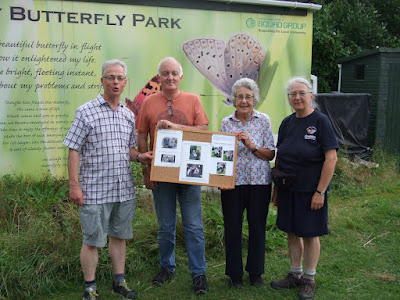 |
| Mike Cottrell and Elaine Mills with the display about Frank, with Paul and Hilary |
Paul Loughnane and Hilary Ash
Monday, 4 September 2023
Tribute to Guy Huntingdon (1949 - 2023)
 |
| Guy Huntingdon |
We were saddened to hear of the death of Guy Huntingdon, after a long illness.
In the 1980s and 1990s he was an active volunteer with Wirral Wildlife, especially at Red Rocks nature reserve.
Guy was born in Upton in 1949 and was interested in photography from his teens. He specialised in natural history and countryside images. He became a member of the Royal Photographic society in 1984. His technical skills and affinity with countryside and wildlife gave lasting impact to his photographs.
He worked with local historian Ken Burnley to produce three illustrated books on Wirral: Images of Wirral (1991), Seasons of Wirral (1994) and Reflections of Wirral (2011). The books feature many images of Wirral's wildlife and wild places including our nature reserves. Ken was our volunteer reserves manager at Red Rocks in the 1980s. Guy was already a warden at Red Rocks before Ken was appointed Reserves Manager and they didn't know each other before then, but became firm friends.
Sunday, 6 August 2023
Spring/Summer 2023 Prize Quiz: Winner and Answers
The quiz had a theme of trees and shrubs. If you want to find out how you did, here are the answers to the cryptic clues.
Saturday, 5 August 2023
30 Years a Wild Flower Grassland
At 10.30am the cream tea making and gazebo transport teams arrived. Gazebos were put up and secured by weights and 140 cream teas prepared. At 1pm stall holders arrived to set up a butterfly craft activity, Wirral Wildlife display, Samaritans plant sale and a beehive demonstration stall. At 1.30 pm the entrance and car parking teams arrived. Crowds gathered at the entrance over the ha-ha for the 2pm opening. The draw bridge was lowered over the ha-ha and visitors entered the enchanting world of the walled garden greeted by a friendly witch. There were musicians, roving archers and story tellers.
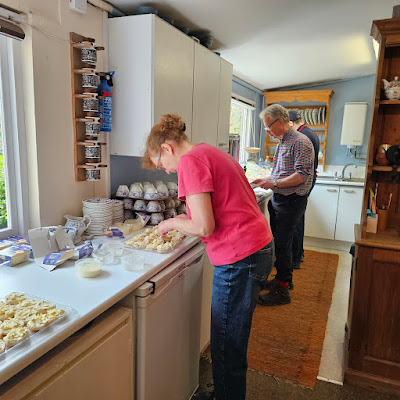 |
| The Cream Tea Team. Photo: John Bateman |
The Walled Gardens, which include an Oriental, a Classical, a Nursery Rhyme and a Witch’s Garden, have interesting artworks inspired by the literary works of Roger Lancelyn Green, his friends and associates: Robin Hood and Excalibur from his Robin Hood and King Arthur retellings, an Ent from J.R.R, Tolkien’s Lord of the Rings, and a Jabberwock from Lewis Carroll’s Through the Looking Glass. The Parkland has a wildflower meadow surrounded by a nine-species laid hedge, each species with at least one tree allowed to grow. Mown paths enable walkers and runners to immerse themselves in it.
Dr Hilary Ash gave two tours of the wildflower grassland outside the ha-ha. The area was used for growing potatoes until 1993. Since then, it has been mown annually in late August or early September, with occasional aftermath grazing. The grassland’s fertility has gradually reduced and the grass sward height and density lowered. Grasses have become finer which has allowed space for marsh orchids to get in and for plants such as meadow buttercup, common sorrel, ribwort, and hairy tare to colonise the grassland. Yellow rattle could be rattled and seeds scattered and there were many meadow brown butterflies on the wing. This area is looking like a classic Cheshire meadow. The marsh orchids and their hybrids were particularly numerous this year. Much patience is required to make a wildflower meadow and this one has been 30 years in the making.
On the second tour Caroline Lancelyn Green, our hostess, joined the tour and expanded on how the hedgerow came about. Two of the far copses were occupied by badgers, one a sett and the other a latrine. The family loved badger watching and wanted to connect the copses up. Further to this there was an old painting in the hall looking over the copses which showed a previous hedge linking them together. In 1993 planting of the hedgerow started, a few sections at a time over the next few winters. Hedgerow shrubs were chosen for coloured flowers, fruits and winter coverage, with a total of nine species, one species for each century the family have lived here.
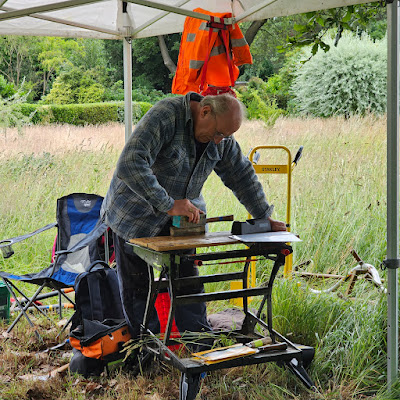 |
| Tool sharpening at the Wirral Countryside Volunteers stall. Photo: John Bateman |
Wirral Countryside Volunteers held a mock ‘come and have a go’ hedge demonstration, tool sharpening, scything, and making a newspaper pot for taking cutting of plants such as rosemary. Three pots completed and then you could take them home in your very own plant incubator, a reused pipette tip holder box. One of the Wirral Countryside Volunteers, Jane, came and helped serve the cream teas and whist she was doing this had her billhook sharpened at the Wirral Countryside Volunteer stall. Jane was very pleased with this. Poulton Hall head gardener, Irene, got her billhook sharpened too and was equally delighted.
A new and interesting stall this year was Wirral Archaeology, a group of well informed and enthusiastic volunteers who research into the battle of Brunanburh in 937AD which is thought to have occurred nearby. This is when an alliance of Dublin Vikings, Scots and Britons came from the north of the peninsular and were defeated by Anglo-Saxon forces as they entered into the Anglo-Saxon part of Wirral. They had many interesting finds, all found within three miles of Poulton Hall, ancient coins, dice, a crotal bell that still worked after several centuries in the ground and Irish arrow heads from pre 950AD. They had excellent enlarged photographs of these artefacts so that you could really appreciate them and volunteers to explain their significance and bring them alive to you.
The day is a wonderful team effort requiring various roles, including being a witch at the entrance to the walled garden! Thank you to the 24 volunteers who made this event possible. This is the third time Wirral Wildlife have held this type of event and it is running along more smoothly each time it is hosted. Thanks also to Roger and Lynn for serving the cream teas, and Scirard, Caroline and Arthur Lancelyn Green and the hall staff for all their support to make it a successful day.
Monday, 24 July 2023
Butterfly Bonanza
Roy Lowry visited New Ferry Butterfly Park on 19th July. Here are the photos of all the species of butterflies he saw, minus a camera shy male brimstone.
What an excellent day!
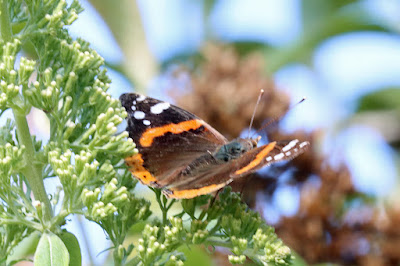 |
| Red admiral |
 |
| Meadow brown (female) |
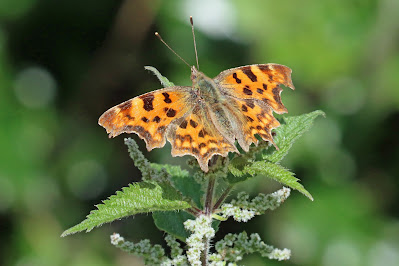 |
| Comma |
 |
| Small copper |
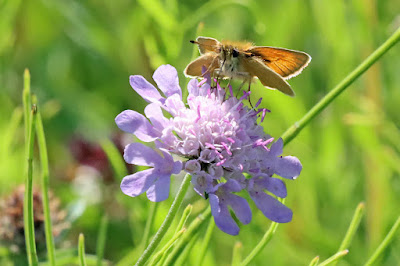 |
| Essex skipper |
 |
| Speckled wood |
 |
| Small white (female) |
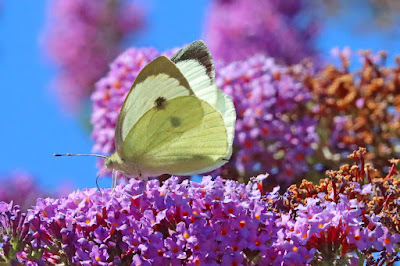 |
| Large white |
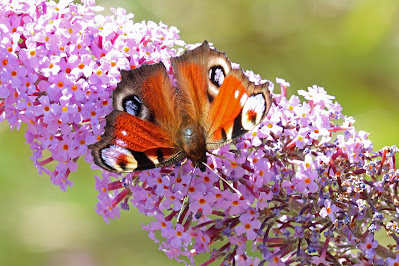 |
| Peacock |
 |
| Small skipper |
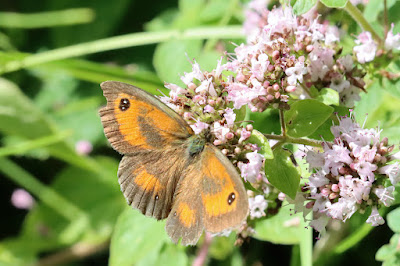 |
| Gatekeeper |
 |
| Green-veined white |
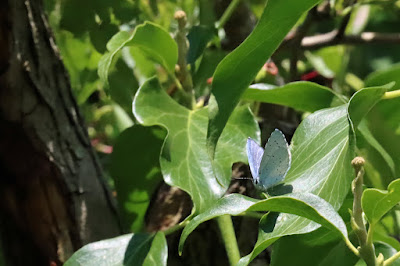 |
| Holly blue (male) |
 |
| Common blue (male) |


